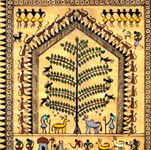Saora folk painting is a type of mural painting native to tribal areas of Odisha. Their wall paintings are known as ‘italons’ or ‘ikons’. These ikons have variety of figures ranging from humans, horse, and elephant to aeroplane, cycle, sun, moon, etc. These paintings and figures are ritualistic in nature and have assoications with divinity and religion. These paintings are easy to make, but difficult to understand as all paintings convey a different message.
Usually these paintings are made in a rectangular or square format or in the shape of a hut enclosed with decorative borders of geometrical shapes. The paintings are usually done with a red background. The materials required for the paintings are also simple and made from locally available material like red is extracted from red clay, white is extracted from chalk or lime.
With the passage of time and commercialization, the medium for Saora painting also changed. They shifted their canvas of mud walls of their houses to wooden frames, paper and various other commercial mediums like textiles, crockery, etc.
The art of the Sauras a tribe based in Orissa, draws inspiration and direction from their spiritual and religious beliefs. It functions as a means of worship and a medium of invocation.
Over the centuries, the Sauras have developed an elaborate system of sacrifices and procedures involving magic, incantation, charm and sorcery intended to compliment and offer praise to the spirits thereby appeasing them. One such practices is that of painting on the walls of their homes as these spaces serve as temporal resting spaces in the living world for the spirits. Their arts create a consecrated space within domestic dwellings. This tightly knit world of people and spirits is the base of saura Art.
The artist rendering the artwork is directed by the shaman or may get possessed himself when invoking the spirits to guide his hand. Using fresh red earth and water to provide a good background the painter uses a twig as a brush. The main colour – white is usually sourced from rice, ash, chalk or lime mixed with water, with lamp black, red ochre, indigo blue and yellow also used.
The stylistic variation can be grouped in four categories. Each group is identified with the village that is centrally located in the area and the style is named after the village Puttasingh, Padampur (Koraput district) Seranga and Mohana (Ganjam district)


